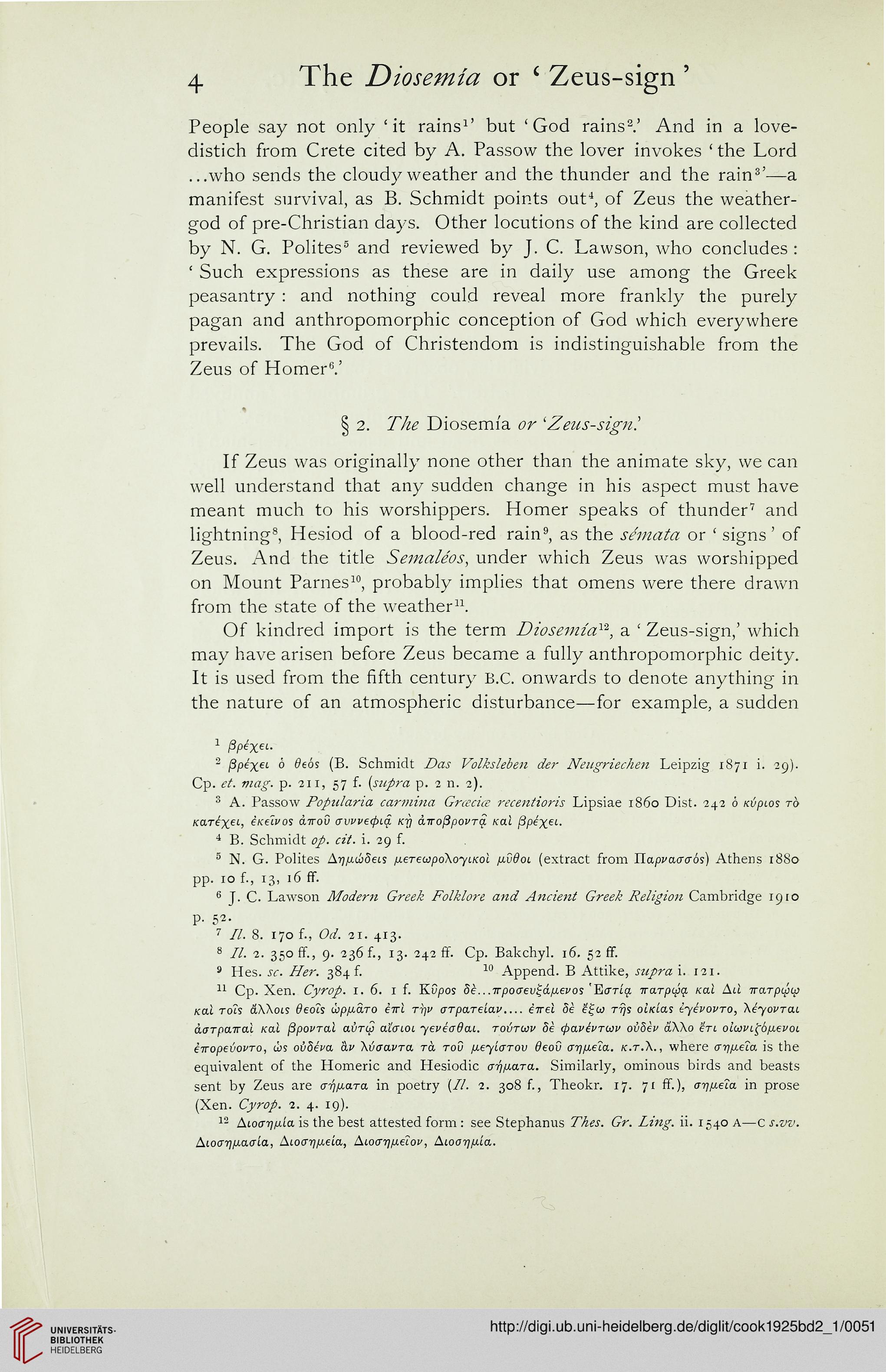4
The Diosemia or 6 Zeus-sign '
People say not only 'it rains1' but 'God rains2.' And in a love-
distich from Crete cited by A. Passovv the lover invokes 'the Lord
...who sends the cloudy weather and the thunder and the rain3'—a
manifest survival, as B. Schmidt points out4, of Zeus the weather-
god of pre-Christian days. Other locutions of the kind are collected
by N. G. Polites5 and reviewed by J. C. Lawson, who concludes :
' Such expressions as these are in daily use among the Greek
peasantry : and nothing could reveal more frankly the purely
pagan and anthropomorphic conception of God which everywhere
prevails. The God of Christendom is indistinguishable from the
Zeus of Homer6.'
§ 2. The Diosemi'a or ''Zeus-sign!
If Zeus was originally none other than the animate sky, we can
well understand that any sudden change in his aspect must have
meant much to his worshippers. Homer speaks of thunder7 and
lightning8, Hesiod of a blood-red rain9, as the semata or ' signs' of
Zeus. And the title Semaleos, under which Zeus was worshipped
on Mount Parnes10, probably implies that omens were there drawn
from the state of the weather11.
Of kindred import is the term Dwsemi'a1'2, a ' Zeus-sign,' which
may have arisen before Zeus became a fully anthropomorphic deity.
It is used from the fifth century B.C. onwards to denote anything in
the nature of an atmospheric disturbance—for example, a sudden
2 /3pe%et ° ^e°s (B. Schmidt Das Volksleben der Neugriechen Leipzig 1871 i. 29).
Cp. et. mag. p. 211, 57 f. (supra p. 2 n. 2).
3 A. Passow Popularia carmina Grcecice recentioris Lipsiae i860 Dist. 242 6 Kvptos to
/car^xei, enelvos airov avvvecpia kt) airofipovTa Kal /3pe'xe'.
4 B. Schmidt op. cit. i. 29 f.
5 N. G. Polites ArjpuLSeis fxereupoXoyiKol /xudoi (extract from liapvaaabs) Athens 1880
pp. 10 f., 13, 16 ff.
6 J. C. Lawson Modern Greek Folklore and Ancient Greek Religion Cambridge 1910
p. 52.
7 //. 8. 170 f., Od. 21. 413.
8 II. 2. 350 ff., 9. 236 f., 13. 242 ff. Cp. Bakchyl. 16. 52 ff.
9 Hes. sc. Her. 384 f. 10 Append. B Attike, stipra i. 121.
11 Cp. Xen. Cyrop. 1.6. if. KOpos 5e.. .irpoaev^atievos "Earia irarpipq, Kal Ad warpuLp
Kal tols dXXois deots Copfxaro iirl tt\v arpareiav.... eirel Se £fw rrjs ot/aas tyevovro, \eyovraL
darpawal Kal (3poi>ral avr<3 aiaioi yeviadai. tovtwv 8e (pav£i>twv ovSeu aWo £tl oiuvL^bp.tvoi.
iiropevovro, WS ov5eva av \vaavra ra rod p-eyiarov deov o~r]p:eM. k.t.X., where crrt/xeia is the
equivalent of the Homeric and Hesiodic cr^/xara. Similarly, ominous birds and beasts
sent by Zeus are o-rj/j-ara in poetry (//. 2. 308 f., Theokr. 17. 71 ff.), a-rifieTa in prose
(Xen. Cyrop. 2. 4. 19).
12 Atoar/fxia is the best attested form : see Stephanus Thes. Gr. Ling. ii. 1540 A—c s.vv.
Aioo-7)fxao-ia, Aiocnj/xei'a, Aioo-r}fxeiov, Atoorjfxia.
The Diosemia or 6 Zeus-sign '
People say not only 'it rains1' but 'God rains2.' And in a love-
distich from Crete cited by A. Passovv the lover invokes 'the Lord
...who sends the cloudy weather and the thunder and the rain3'—a
manifest survival, as B. Schmidt points out4, of Zeus the weather-
god of pre-Christian days. Other locutions of the kind are collected
by N. G. Polites5 and reviewed by J. C. Lawson, who concludes :
' Such expressions as these are in daily use among the Greek
peasantry : and nothing could reveal more frankly the purely
pagan and anthropomorphic conception of God which everywhere
prevails. The God of Christendom is indistinguishable from the
Zeus of Homer6.'
§ 2. The Diosemi'a or ''Zeus-sign!
If Zeus was originally none other than the animate sky, we can
well understand that any sudden change in his aspect must have
meant much to his worshippers. Homer speaks of thunder7 and
lightning8, Hesiod of a blood-red rain9, as the semata or ' signs' of
Zeus. And the title Semaleos, under which Zeus was worshipped
on Mount Parnes10, probably implies that omens were there drawn
from the state of the weather11.
Of kindred import is the term Dwsemi'a1'2, a ' Zeus-sign,' which
may have arisen before Zeus became a fully anthropomorphic deity.
It is used from the fifth century B.C. onwards to denote anything in
the nature of an atmospheric disturbance—for example, a sudden
2 /3pe%et ° ^e°s (B. Schmidt Das Volksleben der Neugriechen Leipzig 1871 i. 29).
Cp. et. mag. p. 211, 57 f. (supra p. 2 n. 2).
3 A. Passow Popularia carmina Grcecice recentioris Lipsiae i860 Dist. 242 6 Kvptos to
/car^xei, enelvos airov avvvecpia kt) airofipovTa Kal /3pe'xe'.
4 B. Schmidt op. cit. i. 29 f.
5 N. G. Polites ArjpuLSeis fxereupoXoyiKol /xudoi (extract from liapvaaabs) Athens 1880
pp. 10 f., 13, 16 ff.
6 J. C. Lawson Modern Greek Folklore and Ancient Greek Religion Cambridge 1910
p. 52.
7 //. 8. 170 f., Od. 21. 413.
8 II. 2. 350 ff., 9. 236 f., 13. 242 ff. Cp. Bakchyl. 16. 52 ff.
9 Hes. sc. Her. 384 f. 10 Append. B Attike, stipra i. 121.
11 Cp. Xen. Cyrop. 1.6. if. KOpos 5e.. .irpoaev^atievos "Earia irarpipq, Kal Ad warpuLp
Kal tols dXXois deots Copfxaro iirl tt\v arpareiav.... eirel Se £fw rrjs ot/aas tyevovro, \eyovraL
darpawal Kal (3poi>ral avr<3 aiaioi yeviadai. tovtwv 8e (pav£i>twv ovSeu aWo £tl oiuvL^bp.tvoi.
iiropevovro, WS ov5eva av \vaavra ra rod p-eyiarov deov o~r]p:eM. k.t.X., where crrt/xeia is the
equivalent of the Homeric and Hesiodic cr^/xara. Similarly, ominous birds and beasts
sent by Zeus are o-rj/j-ara in poetry (//. 2. 308 f., Theokr. 17. 71 ff.), a-rifieTa in prose
(Xen. Cyrop. 2. 4. 19).
12 Atoar/fxia is the best attested form : see Stephanus Thes. Gr. Ling. ii. 1540 A—c s.vv.
Aioo-7)fxao-ia, Aiocnj/xei'a, Aioo-r}fxeiov, Atoorjfxia.




